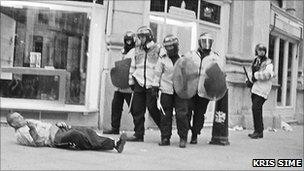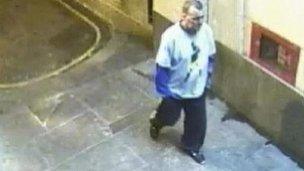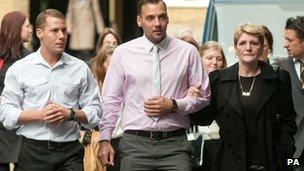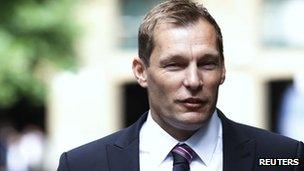Timeline: Ian Tomlinson's death
- Published

Newspaper seller Ian Tomlinson fell to the ground after being pushed by a police officer
The family of Ian Tomlinson, who died after being pushed to the ground by PC Simon Harwood during the G20 protests in 2009, has received an unreserved apology and out-of-court settlement from the Metropolitan Police. Mr Harwood was found not guilty of manslaughter last year.
Here are details of Mr Tomlinson's death and the subsequent events that led up to his inquest and the court case.
1 April 2009
Newspaper vendor Ian Tomlinson tries to head home along King William Street, near the Bank of England, at about 19:00 BST, but is caught up in a crowd of G20 protesters and turned back at a police cordon.
A short time later, trying a different route, he walks along Royal Exchange.
He is hit with a baton and pushed to the ground by a police officer but gets up and walks away only to collapse at about 19:25 BST in nearby Cornhill. He is attended to by police medics but dies a short time later.
4 April
Following a post-mortem examination by Home Office pathologist Dr Freddy Patel, City of London Police say that Mr Tomlinson died of "natural causes" after suffering a fatal heart attack linked to coronary artery disease.
7 April

Ian Tomlinson was trying to make his way home through the G20 protests in the City of London
Amateur video footage emerges of Mr Tomlinson being pushed to the ground from behind by a police officer. The footage is passed to the Guardian newspaper.
In the video, the newspaper seller is seen walking with his back to a group of police when the officer lunges at him.
Other witnesses come forward to claim Mr Tomlinson was also hit by police in the minutes leading up to when the footage was filmed.
8 April
The Independent Police Complaints Commission (IPCC) takes over the inquiry and orders a second post-mortem examination in an attempt to determine whether any external factors contributed to Mr Tomlinson's fatal heart attack.
9 April
PC Simon Harwood is suspended. It emerges that he is a constable from the Metropolitan Police's territorial support group, based in Lambeth, south London.
Scotland Yard now acknowledges Mr Tomlinson did come "into contact with police" before he died, but denies it had earlier tried to mislead the public by suggesting officers' first contact with him was when they tried to administer first aid.
11 April
Mr Tomlinson's relatives say they are "hopeful" that action will be taken against any police officer whose wrongdoing contributed to his death.
17 April
The IPCC says the police officer - later named as PC Simon Harwood - has been interviewed under caution on suspicion of manslaughter.
Meanwhile, the second post-mortem examination finds the cause of Mr Tomlinson's death was abdominal bleeding, caused by some kind of blow, and not a heart attack.
20 April
A third post-mortem examination is ordered at the request of the Metropolitan Police. It agrees with the conclusions of the second - that Mr Tomlinson died from abdominal bleeding.
15 May
Following complaints from Mr Tomlinson's family, the IPCC announces that it will investigate how police handled the release of information to the media in the aftermath of his death.
2 July
Dr Freddy Patel, who carried out the first post-mortem examination, is removed from the Home Office register of accredited forensic pathologists, pending an inquiry into several unrelated cases.
4 August
A file of evidence about the case is passed to the Crown Prosecution Service (CPS) and Mr Tomlinson's widow, Julia, urges prosecutors to let a jury decide whether a police officer played any role in his death.
1 April 2010
A letter to the director of public prosecutions (DPP), signed by campaigners, criticises "intolerable" delays surrounding the investigation of Mr Tomlinson's death.
22 July
The CPS says PC Harwood will not face charges over Mr Tomlinson's death.
The DPP, Keir Starmer, says the decision was taken because there was no prospect of conviction since experts could not agree on how he died.
The dead man's stepson describes the decision as "outrageous".
26 July
Attorney General Dominic Grieve says it is "profoundly unsatisfactory" that "a conflict of evidence" led to no charges being brought over Mr Tomlinson's death.
27 July
The Met Police says PC Harwood will face disciplinary proceedings for alleged gross misconduct. He is accused of using force that "was not necessary, proportionate or reasonable in the circumstances".
3 September
Pathologist Dr Patel is suspended from the medical register for three months after the General Medical Council finds him guilty of misconduct and "deficient professional performance" in relation to the autopsies of three children.
The CPS says it is "considering the GMC's findings" in light of his involvement in Mr Tomlinson's case. It had previously stated the GMC's verdict would have "no bearing" on its decision not to charge anyone over his death.
14 October
DPP Keir Starmer says he is sticking by his decision not to prosecute PC Harwood, despite the suspension of Dr Patel.
10 November
Peter Thornton QC, a senior judge and expert in protest law, is appointed to oversee Mr Tomlinson's inquest - replacing coroner Paul Matthews. He promises to conduct the inquiry with "thoroughness, fairness and fearlessness".
6 January 2011
It is announced that the inquest into Mr Tomlinson's death will be held in March.
28 March

Mr Tomlinson's family sat through the inquest and later trial
The inquest into Mr Tomlinson's death starts in central London, with the evidence lasting until 21 April.
The jury is told of Mr Tomlinson's actions on the day and police, including PC Harwood, describe their involvement. The medical reasons for Mr Tomlinson's death are also explored. The inquest hears from three of the four pathologists who carried out post-mortem examinations, as well as other medical experts.
3 May
The inquest jury says Mr Tomlinson was unlawfully killed by PC Harwood. The officer is said to have used "excessive and unreasonable" force in striking him.
4 May
Evidence that emerged during the inquest into Mr Tomlinson's death is to be reviewed, the DPP announces.
Keir Starmer will decide if the policeman who pushed the 47-year-old to the ground at London's G20 protests should be charged with manslaughter.
24 May
The DPP said there was now a "realistic prospect" of convicting PC Harwood as he announces the officer is to face a manslaughter charge.
20 June
PC Harwood appears at City of Westminster Magistrates' Court charged with manslaughter and is bailed until 17 October.
17 October
PC Harwood appears at Southwark Crown Court accused of manslaughter and pleads not guilty.
18 June 2012

PC Harwood told the jury of his "shock" when he saw the video footage
PC Harwood goes on trial at Southwark Crown Court. The prosecution said Mr Tomlinson died as the result of a "gratuitous act of aggression by a lone officer whose blood was up".
PC Harwood tells the court he now knows it was "wrong" of him to hit Mr Tomlinson but did so because he had felt the newspaper vendor was being deliberately obstructive and was encouraging officers to take action to move him on. He tells the jury of his "shock" when he saw the video footage and realised the consequences of his actions.
19 July
PC Harwood is found not guilty of the manslaughter of Mr Tomlinson.
The jury at Southwark Crown Court had considered their verdict for four days.
During the trial, the police officer accepted it was "wrong" to have hit and pushed Mr Tomlinson.
He said that, had he realised at the time that Mr Tomlinson was walking away from police lines, he "would not have gone near him".
23 August
Pathologist Dr Patel is struck-off the medical register by the Medical Practitioners Tribunal Service, which finds that he had an "unwarranted confidence" in his abilities, "a deep-seated attitudinal problem" and also "lacked insight".
17 September
PC Harwood is found guilty of gross misconduct by a Metropolitan Police disciplinary panel and sacked with immediate effect.
The panel found that he had breached standards on discreditable conduct, use of force and authority, respect and courtesy, and that this should be counted as gross misconduct.
Mr Tomlinson's family left the hearing before PC Harwood was dismissed from the force, saying the process was "pointless" and left them with "no answers".
They said they intended to pursue the case in civil court to try and establish who was responsible for Mr Tomlinson's death.
5 August 2013
The Met agrees an out-of-court compensation settlement and apologises "unreservedly" to Mr Tomlinson's family for the use of "excessive and unlawful force".
His widow, Julia, says it is the closest the family will get to justice, while his stepson Paul King says they can now "move on with our lives".
Deputy Assistant Commissioner Maxine de Brunner says she takes full responsibility for the then-PC Harwood's actions. She also admits that mistakes were made when it came to the Met disciplining and vetting the former officer.